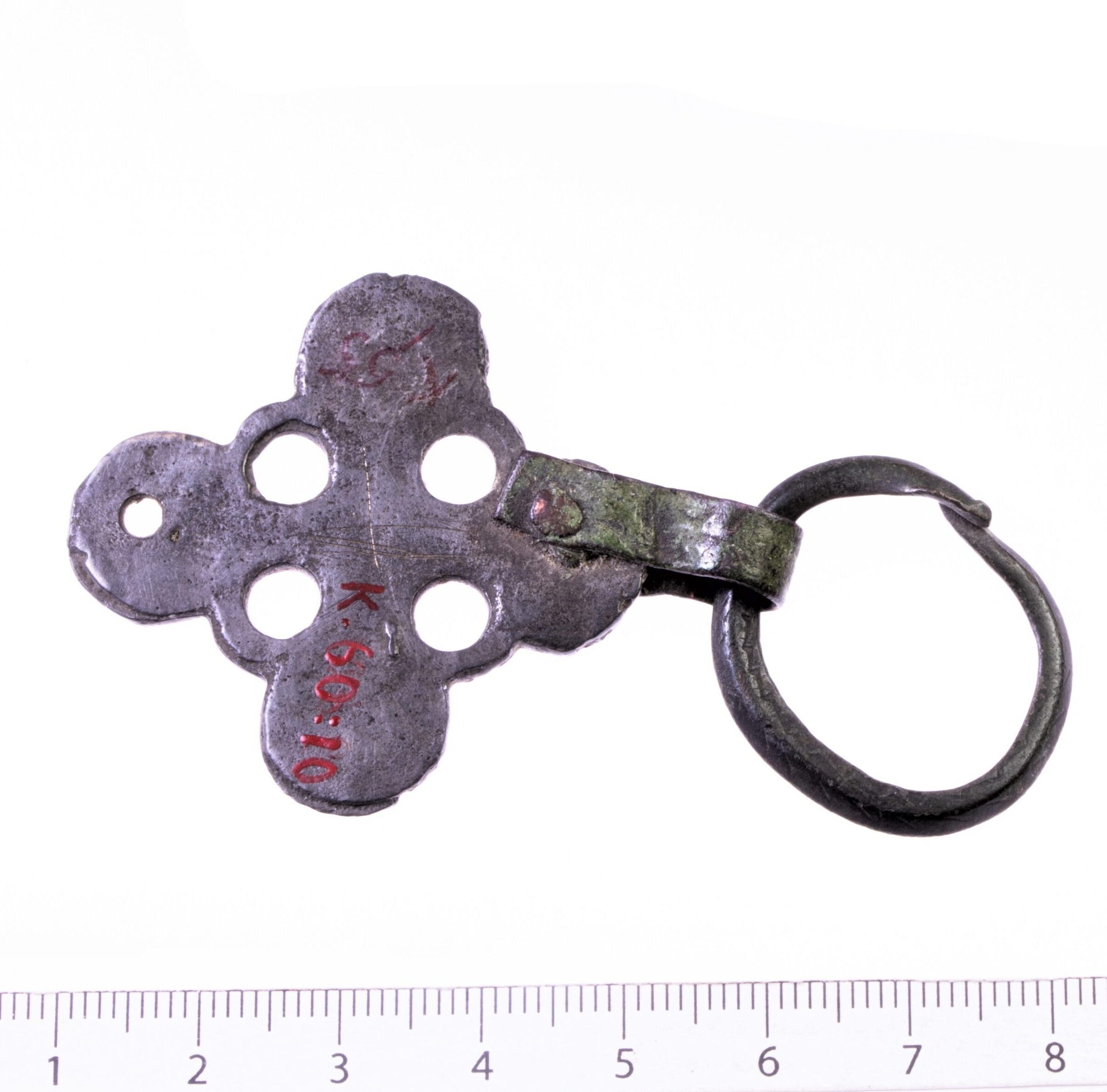Database
Our database is free to use for all history and archaeology enthusiasts. If you use our database, please do not forget to cite correctly:
Mägi, Marika; Palm, Piia Sandra. Archaeological Artefacts of Saaremaa. Foundation Osiliana / Tallinn University. Accessed: date.
The Osiliana Archaeological Database presents artefacts from Saaremaa and the surrounding small islands.
The database contains mainly Iron Age and Medieval finds that can be classified.
Undated metal or other pieces were generally excluded from the database.
Ceramics are represented by isolated examples.
The database is a work in progress and is constantly being updated.
Upa
Spearhead, iron. With tang, with a round neck of circular cross-section, with rounded edges. Blade patten-welded.


Spearhead, iron. With tang, with a round neck of circular cross-section, with rounded edges. Blade patten-welded. Based on Russian analogues, it can be dated from the 9th to the beginning of the 11th century (Kirpitchnikov 1966b, fig. 1).
Literature:
Kirpichnikov 1966b = Кирпичников, А. H. 1966. Древнерусское оружие IX – XIII вв. Выпуск 2. Копья, сулицы, боевые топоры, булавы, кистени. Наука: Москва.
Upa
Spearhead, iron. Narrow, almost oval blade, long neck and socket.

Spearhead, iron. Narrow, almost oval blade, long neck and socket. Such spearheads with a long neck and a long socket are dated in Finland to the 5th-6th century. (Kivikoski 1973, 52, Pl. 36:303).
Literature:
Kivikoski, E. 1973. Die Eisenzeit Finnlands. Bildwerk und Text. Neuausgabe. Helsinki.
Upa
Spearhead, iron. With socket and rhombic blade.

Spearhead, iron. With socket and rhombic blade. Such spearheads are dated in Latvia to the 13th-14th centuries, especially to the period after the mid-13th century, although similar spearheads spread in Europe as early as the late 12th century (Brūzis 2012, 74-75). Similar ones have been found in Saaremaa, for example in the Rahu cemetery, where they are previously dated to the 11th century (Mägi 2002, Pl. XII, XV), but are probably later. Late 12th century – ca 1300.
Literature:
Brūzis, R. 2012.14.-16. gadsimta tuvcīņas ieroči Rīgā. – Sēna Rīga, 7. Pētījumi pilsētas arheoloģijā un vēsturē. Latvijas vēstures institūta apgāds: Rīga, 64-94.
Mägi, M. 2002. At the Crossroads of Space and Time. Graves, Changing Society and Ideology on Saaremaa (Ösel), 9th–13th centuries AD. CCC papers: 6. Gotland University College, Centre for Baltic Studies; Institute of History, Department of Archaeology. Tallinn, 2002. Read the book: here. Look at the drawings of the archaeological excavations: here.

Upa
Cross-headed pin, bronze. The pin-head has rounded ends, connected by curved branches. Shaft broken. Such small pins are characteristic of 13th-century inhumations, they are rare in prehistoric stone graves.
Upa
Cross-headed pin made into cross-shaped pendant, bronze. The four rounded ends of the pin-head are connected by curved arches. Such pins are frequently found in 13th-century inhumations, seldom in prehistoric stone graves. The pendant dates to the 13th-14th centuries.


Cross-headed pin made into cross-shaped pendant, bronze. The four rounded ends of the pin-head are connected by curved arches. Such pins are frequently found in 13th-century inhumations, seldom in prehistoric stone graves. The pendant dates to the 13th-14th centuries.
Upa
Penannular brooch with blossom-shaped terminals, copper alloy. The cross-section of the ring is flat rhomb, with a broad base of the pin.



Penannular brooch with blossom-shaped terminals, copper alloy. The cross-section of the ring is flat rhomb, with a broad base of the pin. Ring with wolf-tooth ornamentation, the needle decorated with circles. As some of such brooches are known from Saaremaa stone graves, it is possible that the type appeared as early as in the 12th century (Mägi 2002, 102). In Siksälä grave, SE-Estonia, they are dated to the 14th-15th centuries (Valk & Laul 2014, 102-103). The Upa brooch probably dates to the 14th century.
Literature:
Mägi, M. 2002. At the Crossroads of Space and Time. Graves, Changing Society and Ideology on Saaremaa (Ösel), 9th–13th centuries AD. Tallinn: Ajaloo Instituut, Tallinn/Center of Baltic Studies, Gotland.
Valk, H. & Laul, S. 2014. Siksälä kalme I. Muistis ja ajalugu. Tartu Ülikool, Ajaloo ja arheoloogia instituudi arheoloogia osakond. Tartu.
Upa
Sword, iron. The handle is decorated with a pattern of triangular motifs in silver engraving.


Sword, iron. Petersen’s T-type, dated to the second half of the 10th century in Scandinavia (Petersen 1919, 152, 183). The hilt is decorated with a pattern of triangular motifs in silver inlay. Swords of this type were common not only in Estonia but also in the areas of Latvia and Russia inhabited by the Baltic Finns, and in Finland, where they can be dated mainly to the 10th, but sometimes also to the 11th century (Moilanen 2015, 153-154; Tomsons 2018, 62-65).
Literature:
Moilanen, M. 2015. Marks of Fire, Value and Faith. Swords with Ferrous Inlays in Finland during the Late Iron Age (ca. 700–1200 AD). Suomen Keskiajan Arkeologian Seura: Turku.
Tomsons, A. 2018. Zobeni Latvijas teritorijā no 7. līdz 16. gadsimtam. – Latvijas nacionālā vēstures muzeja raksti nr. 27. Rīga.
Upa
Spearhead, iron. Silver plated, with ornamented socket.

Spearhead, iron. Silver plated, with ornamented socket. Petersen’s type I or K from the 10th century (Petersen 1919, 31-33; Pedersen 2014, 94). It is on display in the Saaremaa Museum (2024).
Kirjandus:
Pedersen, A. 2014. Dead Warriors – a study of weapon and equestrian burials in viking-age Denmark, AD 800-1000. National Museum Studies in Archaeology. University Press of Southern Denmark: Odense.
Petersen, J. 1919. De norske vikingesverd. En typologisk-kronologisk studie over vikingetidens vaaben. (Videnskapsselskapets Skrifter II. Hist. – Filos. klasse 1.) Kristiania.
Upa
Handmade ceramics, decorated with a lattice ornament. This type of pottery with lattice patterns was characteristic of north-western and western Estonia and Saaremaa.

Handmade ceramics, decorated with a lattice ornament. This type of pottery with lattice patterns was characteristic of north-western and western Estonia and Saaremaa. 11th-12th century (Tvauri 2005, 92-101).
Literature:
Tvauri, A. 2005. Eesti hilisrauaaja savinõud. – Muinasaja teadus, 16. Tartu-Tallinn.
The negative value refers to time Before Christ.









